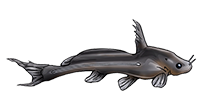
Article © Heok Hee Ng, uploaded December 04, 2012.
Of all the rivers in Asia, the Mekong River is known to contain the greatest number of fish species. Documenting the incredibly rich fish fauna of the Mekong River drainage has been a challenge, especially since scientists cannot agree on the exact number of species found there (estimates ranging from 700 to more than 1,000, although the lower number seems more accurate). This book is a first attempt to inventory the fish fauna of the Mekong River drainage from its headwaters in Tibet to its mouth (and beyond) in southern Vietnam.
The book is comprised of five sections, with the second (the annotated checklist of fish species) and the fifth (the photographic atlas) being of greatest interest to aquarists. For the layman with an interest in this sort of thing, there is a detailed account of the geology and physical geography of the Mekong River drainage (as well as a brief overview of the problems of the taxonomy of the fishes found within).
More than 2,500 species are covered in this book, which appears to be far in excess of even the highest estimate (1,600) until one realizes that the authors meant for the book to not only cover the Mekong River drainage proper, but also the area by which the river exerts a significant effect on the biota. As this includes the discharge plume of the river that extends far into the South China Sea, species found in the coral reefs of the Gulf of Thailand and the South China Sea are also included in this work. For a book whose main purpose is to cover mostly freshwater fish species, this seems very odd. The number of fish species is also boosted by the inclusion of species not found in the Mekong River drainage but restricted to smaller adjacent rivers.
How useful is this book to aquarists? Well, unless you like to identify your fish by comparing them to tiny photographs, this would not be the Holy Grail you are seeking. The annotated checklist provides nothing more than the locality from which the illustrated fish originates (a brief description of the actual distribution of the species would have been more useful), and both species accounts and dichotomous keys are sorely lacking (although these are promised in an upcoming second installment). As previously mentioned, the photographs are too small to be meaningfully used for identification; bear in mind that to put 2,541 of them large enough to be useful in this regard would make for an elephantine volume.
In summary, this book provides a brief (if slightly misleading) overview of the fishes of the Mekong River drainage, but other books (e.g. Kottelat's “Fishes of Laos”) covering a more geographically circumscribed area may be more useful to aquarists as a guide to the identifying the vast ichthyological diversity of the Mekong River drainage.
Back to Book Reviews index.




